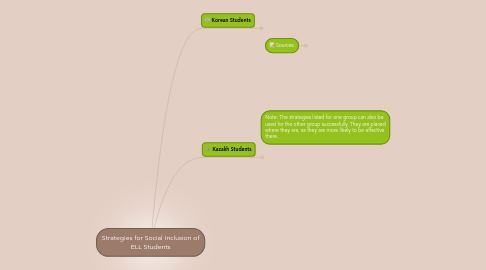
1. Korean Students
1.1. Steps
1.1.1. Make learning relevant
1.1.1.1. When
1.1.1.1.1. At all stages of learning
1.1.1.2. Where
1.1.1.2.1. Inside the classroom during lessons, outside the classroom during events
1.1.1.3. How/What
1.1.1.3.1. By using culturally diverse pieces of text, holidays etc
1.1.1.3.2. Use articles from news. Use the positive ones mainly.
1.1.1.3.3. Moderate discussions that hurt national sentiment
1.1.1.3.4. Celebrate international festivals in small ways
1.1.1.4. Who all?
1.1.1.4.1. Teachers should be modelling behavior
1.1.1.5. Why?
1.1.1.5.1. If students are not socially accepted, all learning will fall apart. Human beings are social animals
1.1.2. Social inclusion rather than pulling out
1.1.2.1. When
1.1.2.1.1. Pulling out is advisable only for those who speak no English and should be phased out in an appropriate amount of time (About a month or two)
1.1.2.2. How/What
1.1.2.2.1. Group activities with diverse group of students
1.1.2.2.2. Limiting the time a student works independently on the computer or other electronic equipment during class
1.1.2.3. Who
1.1.2.3.1. All students
1.1.2.3.2. Conduct deliberate team building activities at the beginning of the year.
1.1.2.4. Where
1.1.2.4.1. In structured activities inside the classroom.
1.1.2.5. Why
1.1.2.5.1. The more they get to know one another, the more their prejudices and ignorance are confronted
1.1.3. Encourage students to join a sports team
1.1.3.1. Who
1.1.3.1.1. All students, all ages
1.1.3.2. When
1.1.3.2.1. In the first week of school itself!
1.1.3.3. How/What
1.1.3.3.1. Join a sports team (or even more than one) depending upon academic responsibilities and availability of time and resources
1.1.3.4. Where
1.1.3.4.1. In school and outside of it
1.1.3.5. Why
1.1.3.5.1. I advocate sports as it is not just an end, it is a means to a larger end of social bonding
1.1.4. Extend interaction beyond the classroom
1.1.4.1. When
1.1.4.1.1. At the beginning of the year
1.1.4.2. Who
1.1.4.2.1. You do it initially and your students will take over even before you realize
1.1.4.3. How/What
1.1.4.3.1. Encourage parents of younger kids to have play dates
1.1.4.3.2. Arrange with your school to provide after school activities like bands
1.1.4.3.3. Take a an overnight trip
1.1.4.4. Where
1.1.4.4.1. Everywhere you possibly can : after school, on weekends, outside of town
1.1.4.5. Why
1.1.4.5.1. By far the most effective in student bonding in the least amount of time
1.1.5. Use diversity as a resource
1.1.5.1. When
1.1.5.1.1. Always
1.1.5.2. Who
1.1.5.2.1. Teachers and Students as a class
1.1.5.3. How/What
1.1.5.3.1. By socially including all students in one classroom, there is immense scope for peer tutoring
1.1.5.3.2. Make learning meaningful by linking it to students' past experiences and culture
1.1.5.3.3. Students from different parts of the world contribute to a diverse range of projects with the same set of student outcomes and assignments.
1.1.5.4. Where
1.1.5.4.1. In the classroom, at the field
1.1.5.5. Why
1.1.5.5.1. Convert weaknesses into strengths
1.2. Checkpoint
1.2.1. Silent phase or the phase of language acquisition
1.2.2. Test scores
1.2.3. Student satisfaction
1.2.4. Signs of struggle
2. Kazakh Students
2.1. Steps
2.1.1. Local field trips
2.1.1.1. When
2.1.1.1.1. In the first three months of the academic year
2.1.1.2. Who
2.1.1.2.1. Mixed group of local (Kazakh) and expat teachers and students with local students taking ownership and responsibility
2.1.1.3. What/How
2.1.1.3.1. Day trips that align with the curriculum
2.1.1.4. Where
2.1.1.4.1. To places of national heritage and sometimes entertainments centers like bowling or paintball
2.1.1.5. Why
2.1.1.5.1. Every country has some richness in its country. This will promote positive feelings for the country in the minds of expats and greater self-respect in the minds of natives of a young and not-so-famous nation.
2.1.2. Use small group discussions to teach but respect the language acquisition period
2.1.2.1. When
2.1.2.1.1. All throughout the year
2.1.2.2. Who
2.1.2.2.1. All students grouped deliberately by the teacher
2.1.2.3. What/How
2.1.2.3.1. Teacher should act as a facilitator to learning
2.1.2.4. where
2.1.2.4.1. In all classes
2.1.2.5. Why
2.1.2.5.1. Another way to confront ignorance and prejudices. Benefit from diverse knowledge and cultural experiences. Smaller groups also provide for a safer environment for ELL Students
2.1.3. Time outs of English
2.1.3.1. When
2.1.3.1.1. More in the beginning of the year and less after they have achieved a comfortable level of conversational English
2.1.3.2. Who
2.1.3.2.1. All students whether ELL or not
2.1.3.3. What/How
2.1.3.3.1. 'Time-out of English' to converse in a language of their choice. This can be done halfway through a block
2.1.3.4. Where
2.1.3.4.1. Where it does not disrupt functioning
2.1.3.5. Why
2.1.3.5.1. It is very important for ELLs to give went to their feelings
2.1.4. Learn the language and make mistakes
2.1.4.1. When
2.1.4.1.1. Early on
2.1.4.2. Who
2.1.4.2.1. You! Who else???
2.1.4.3. What/How
2.1.4.3.1. Learn a few words in the local language and use them appropriately. Greetings and words of encouragement like 'Good Job' or 'terrific' sound reassuring in one's own tongue.
2.1.4.4. Where
2.1.4.4.1. wherever and whenever you need lighter moments in your class. Be the clown!
2.1.4.5. Why
2.1.4.5.1. to send out the message that it is Ok to make mistakes while learning a new language
2.1.5. Be aware of culture shock
2.1.5.1. When
2.1.5.1.1. Day one
2.1.5.2. Who
2.1.5.2.1. You and your students
2.1.5.3. What/How
2.1.5.3.1. Be sensitive to the feelings of the students. Confront defiance of any kind with conversations and lots of patience. Redirect the students to something that is fun.
2.1.5.3.2. Give them time to adjust and start co-operating with you.
2.1.5.4. Where
2.1.5.4.1. mainly outside of class so that they are not embarrassed in front of their peers.
2.1.5.5. Why
2.1.5.5.1. Break that ice! Take ownership of your students.
2.2. Checkpoint
2.2.1. Student scores
2.2.2. Student and parent survey
2.2.3. Class observations
2.2.4. Any behavioral manifestation
